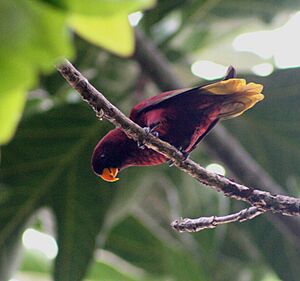Pohnpei lorikeet facts for kids
Quick facts for kids Pohnpei lorikeet |
|
|---|---|
 |
|
| In Pohnpei, Micronesia | |
| Conservation status | |
| Scientific classification | |
| Genus: |
Trichoglossus
|
| Species: |
rubiginosus
|
The Pohnpei lorikeet (Trichoglossus rubiginosus) is a special type of parrot. People on the island of Pohnpei call it serehd. This colorful bird belongs to the Psittaculidae family.
It lives only on the island of Pohnpei and the nearby Ant Atoll. Both are part of Micronesia. Long ago, this lorikeet might have lived in more places across Micronesia.
Contents
About the Pohnpei Lorikeet
What the Pohnpei Lorikeet Looks Like
The Pohnpei lorikeet is about 24 centimeters (9.4 inches) long. It weighs around 80 grams (2.8 ounces). Its feathers are mostly a reddish-maroon color. It has darker maroon stripes that are hard to see.
The bird's head is a bit darker maroon. Its wing feathers and tail are olive-yellow. The legs of the lorikeet are grey.
You can tell male and female lorikeets apart by their beaks and eyes. Males have an orange beak and yellow-orange eyes. Females have a yellow beak and light grey eyes. Young lorikeets, called juveniles, have brown beaks and brown eyes.
Where the Pohnpei Lorikeet Lives and What it Eats
The Pohnpei lorikeet makes its home in tropical forests. It also lives in tree plantations. These are places where trees are grown, like coconut farms.
This bird loves to eat nectar and pollen. It often gets these from coconut flowers. It also enjoys eating fruit and tiny insect larvae.
When it's time to have babies, the Pohnpei lorikeet builds a nest. It finds a hole inside a tree. The female lorikeet usually lays just one egg.
Good news! This bird is quite common. It is not considered to be in danger of disappearing.
The Pohnpei Lorikeet in Human Culture
The Pohnpei lorikeet is very important to the people of Pohnpei. It has been chosen as the official state bird of Pohnpei. This was made official by a law called the "Designation of State Bird Act."
This law also helps to protect the bird. It means that people are not allowed to hunt or kill the Pohnpei lorikeet. If someone breaks this law, they can face fines or even go to jail. This shows how much the people of Pohnpei value their special bird.


